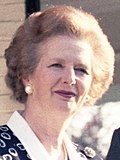1987 United Kingdom general election
A general election was held on 11 June 1987 to elect all 650 members to the House of Commons of the United Kingdom. The Conservative Party won the election, winning 376 seats, and Margaret Thatcher stayed as Prime Minister for the third election in a row. The Labour Party won 20 more seats than the last election, mostly from the Conservatives.
| |||||||||||||||||||||||||||||||||||||||||||||
All 650 seats in the House of Commons 326 seats needed for a majority | |||||||||||||||||||||||||||||||||||||||||||||
|---|---|---|---|---|---|---|---|---|---|---|---|---|---|---|---|---|---|---|---|---|---|---|---|---|---|---|---|---|---|---|---|---|---|---|---|---|---|---|---|---|---|---|---|---|---|
| Opinion polls | |||||||||||||||||||||||||||||||||||||||||||||
| Turnout | 75.3%, | ||||||||||||||||||||||||||||||||||||||||||||
| |||||||||||||||||||||||||||||||||||||||||||||
 Colours denote the winning party—as shown in § Results | |||||||||||||||||||||||||||||||||||||||||||||
 Composition of the House of Commons after the election | |||||||||||||||||||||||||||||||||||||||||||||
| |||||||||||||||||||||||||||||||||||||||||||||
1987 United Kingdom General Election Media
Sources
- Butler, David E.; Kavanagh, Dennis (1988), The British General Election of 1987, the standard scholarly study
{{citation}}: CS1 maint: postscript (link) - Craig, F. W. S. (1989), British Electoral Facts: 1832–1987, Dartmouth: Gower, ISBN 0900178302
- Craig, F. W. S., ed. (1990), British General Election Manifestos, 1959–1987
- Crewe, Ivor; Harrop, Martin (1989), Political Communications: The General Election Campaign of 1987, p. 316
- Galbraith, John W.; Rae, Nicol C. (1989), "A Test of the Importance of Tactical Voting: Great Britain, 1987", British Journal of Political Science, 19 (1): 126–136, doi:10.1017/S0007123400005366, JSTOR 193792, S2CID 154797699
- Scott, Len (2012), "Selling or Selling Out Nuclear Disarmament? Labour, the Bomb, and the 1987 General Election", International History Review, 34 (1): 115–137, doi:10.1080/07075332.2012.620242, S2CID 154319694
- Stewart, Marianne C.; Clarke, Harold D. (1992), "The (un)importance of party leaders: Leader images and party choice in the 1987 British election", Journal of Politics, 54 (2): 447–470, doi:10.2307/2132034, JSTOR 2132034, S2CID 154890477, says the well-organised, media-wise Labour campaign helped Kinnock, but he was hurt by Conservative momentum and Thatcher's image as a decisive leader. Leadership images proved more important in voters' choices than did party identification, economic concerns, etc.
{{citation}}: CS1 maint: postscript (link)






